Articles Menu
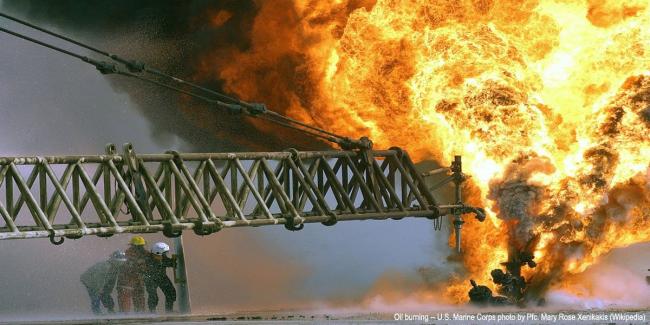
July 16, 2020 - Despite decades of promises to prevent a climate crisis, the primary cause of it, global fossil fuel burning, continues to increase rapidly. Last year's fossil burn broke all records.
That's according to data released by the multinational oil and gas company BP, in the latest "BP Statistical Review of World Energy."
To illustrate humanity's relentless acceleration off the climate cliff, and Canadians' role as top one-percenters, I've dug into the latest BP energy report and created the “missing charts” that show fossil burning trends — both here at home and worldwide.
My first chart shows BP's data for global fossil fuel use since 1990. This is the combined energy from all fossil oil, gas and coal burned each year. As you can clearly see, humanity just keeps burning more and more.
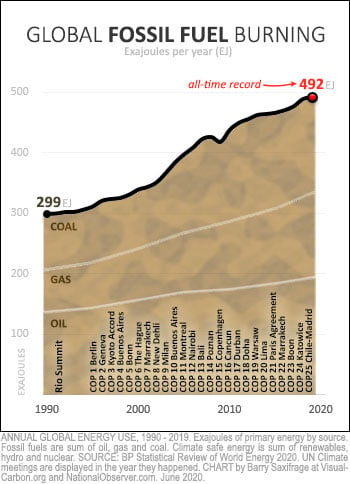
Back in 1992, the world gathered at the Rio Summit promising to prevent our collective fossil fuel pollution from unleashing a full-blown climate crisis onto future generations.
Back then, humans were burning around 300 exajoules (EJ) worth of fossil fuels each year.
But instead of reducing the threat as promised, we collectively cranked up the burning to a record 492 EJ last year.
(Note: An “exajoule” (EJ) is an energy metric used by BP and others to compare different sources of energy. It is roughly equal to the energy from burning 163 million barrels of oil.)
Since that Rio Summit, there has been another quarter century of annual international climate summits. And yet fossil fuel burning has risen in every one of those years.
Except one. In 2009, a sudden worldwide recession caused the one small dip you can see in the chart. However, the very next year fossil fuel burning increased by the most ever recorded. The short-lived hope that the dip and crisis might lead to sustained climate progress turned out to be an illusion as business-as-usual fossil burning returned both fast and furious.
The COVID-19 pandemic is expected to create another yearly drop. But once again, global climate pollution is projected to rebound and continue rising afterwards, under business-as-usual. That's according to a recent analysis by the International Energy Agency (IEA).
"It turns out that we are currently burning more fossil fuels per person than 99 per cent of humanity -- nearly five times the global median."
In that same report, the IEA puts forward an alternative to business-as-usual. They call it a global “sustainable recovery” investment plan. If widely adopted, this plan would prevent emissions from continuing to rise. Of course, plans like this have been created and promoted for decades now. The climate crisis has not been caused by a lack of options and plans. It's been caused by a lack of will to implement them at the scale needed.
One of the great climate hopes has been that rising amounts of renewables and nuclear energy would cause fossil fuel burning to start falling. My next chart shows what happened instead.
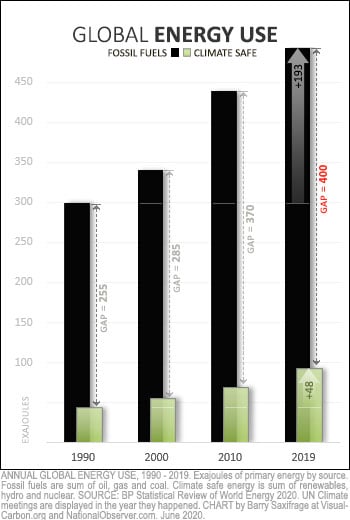
The green bars combine the BP data for all climate-safe energy sources. This includes all renewables (such as hydro, solar and wind) plus nuclear energy.
As you can see, climate-safe energy has indeed grown robustly over the last three decades — rising by 48 EJ.
But, as you can also see, fossil fuel burning has risen four times more — adding 193 EJ.
As a result, fossil burning hasn't just been rising — it's been pulling away from the climate-safe alternatives. In 1990, the energy gap was an eye-watering 255 EJ. Now it's more than 400 EJ.
In the Greek myth symbolizing futility, Sisyphus had to repeatedly push the same boulder up the same hill. When it comes to humanity's primary climate task — replacing fossil carbon burning — we are stuck in the same kind of endless struggle. Each year, the world builds heaps of new climate-safe energy sources. And yet, at the start of the next year, the amount that needs to be built is even larger. Our boulder keeps getting bigger.
One clean step forward and four dirty steps back.
One beguiling statistic is that fossil fuels are losing market share to renewables. That's often held up as a sign of climate progress. Unfortunately, it hasn't been so far. My next chart digs into the BP data to illustrate why.
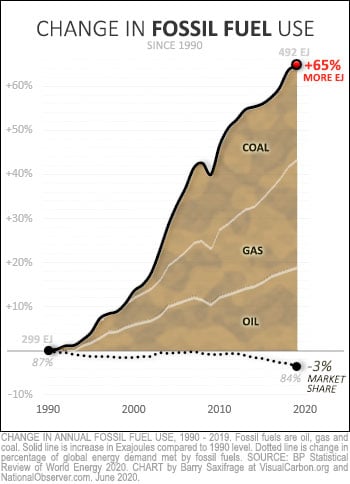
See that dotted line at the bottom? That shows the market share for fossil fuels since 1990. Sure enough, it has fallen from 87 per cent of global energy use, down to 84 per cent.
The reason that isn't climate progress is that the climate doesn't care about “market share” or how much renewable energy we use. What our climate system reacts to is the total amount of fossil fuels burned. That's the solid black line on the chart. And it, clearly, hasn't fallen. It's rocketed up by 65 per cent. That's what is fuelling the climate crisis. That's what is threatening our future. And that's the line that must fall quickly if we hope to preserve and pass along the safe and sane climate that most of us were fortunate enough to be born into.
Rising fossil burning is not climate progress. It is accelerating climate failure.
This chimera of falling-share-with-rising-amounts can continue for thousands of years, as long as the total energy market keeps growing. So, beware the lovely and comforting siren's song of “worry not, fossil carbon is losing market share to renewables.” It deceptively hides the increasing fury of the storm waves breaking on the rocks dead ahead.
The BP data shows that Canada is one of the world's top-10 fossil burners — both in total amount and per person.
So, our actions and leadership in the fight for a safe climate matter more than those of nearly every other country. And Canada also has what it takes to help lead the world toward a safe climate future. We are one of the world's wealthiest, most tech-savvy, get-it-done countries. And we pride ourselves on doing the right thing and being a force for good in the world.
Plus, politically, both Liberal and Conservative federal governments over the years have stated that Canada aims to be a global climate leader and have collectively pledged to reduce our climate pollution — nine times.
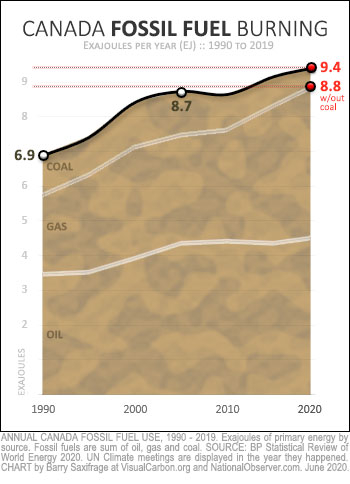
So, how are we doing?
My chart on the right shows Canada's annual fossil burn since 1990.
You can see that we haven't been cutting back as promised. We keep burning more.
One bright spot is that our coal burning has declined. But that relatively small bit of climate progress has been wiped out many times over by our increases in both fossil oil and fossil gas burning.
At this point, eliminating coal won't even get us to back to our starting line. As the chart shows, our rising fossil oil and gas burn is now higher than all our fossil burning (including coal) was in 2005. That's the baseline year we promised to make big cuts from in our Copenhagen and Paris Agreement climate targets.
If we want to start making climate progress in Canada, we'll need to start making significant and sustained reductions in the amount of fossil oil and gas we burn, as well.
What role are renewables playing in Canada's climate efforts? My chart below lets you compare how much of each type of energy we've added since 1990.
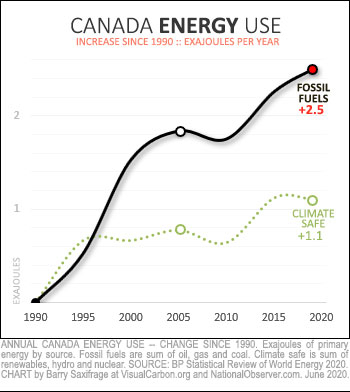
The dotted-green line shows the increase in climate-safe energy since 1990. We've added 1.1 EJ worth.
The black line shows the increase in fossil fuel burning. As you can see, we've added twice as much fossil during that time.
In fact, we've continued to add twice as much fossil even since 2005 — our baseline climate year. As a result, climate-safe energy sources in Canada keep falling ever farther behind climate-damaging ones.
Increasing fossil burning is climate failure.
Increasing fossil burning more than climate-safe alternatives amplifies our exposure to the gathering climate crisis.
How does our fossil burn in Canada compare to our global peers?
My chart below compiles the BP data for fossil burning per person in the world's top eight economies — which includes Canada. Combined, this group accounts for around 80 per cent of global GDP. Obviously, any solution to the climate crisis will require the action and leadership from all these countries.
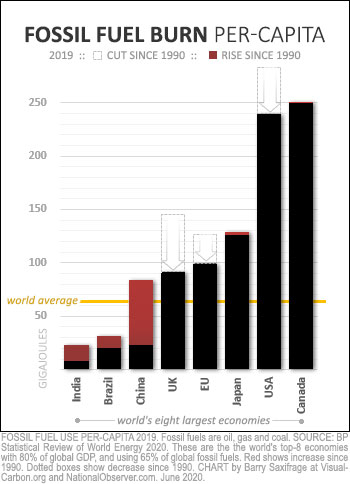
Two things immediately jump out at me about Canada.
First, Canada burns the most per person. We now burn even more than the Americans; twice as much as the Europeans; and three times the global average.
Second, Canadians are still burning as much as we did back in 1990. In fact, we burn a bit more per person now.
In contrast, the Americans cut their fossil burn by 15 per cent per person. The Europeans now burn 22 per cent less. And the U.K. burns 37 per cent less per person than they did in 1990. So, clearly it is possible for wealthy, technologically advanced countries to turn down the fossil burner — at least at the per-person level.
My final chart expands the scope to include the entire world. In this chart, the x-axis shows the running total of the global population. For example, it shows that half the world lives in countries that burn less than 33 GJ per person. While 90 per cent of humanity burns less than 135 GJ per year.
Where are Canadians?
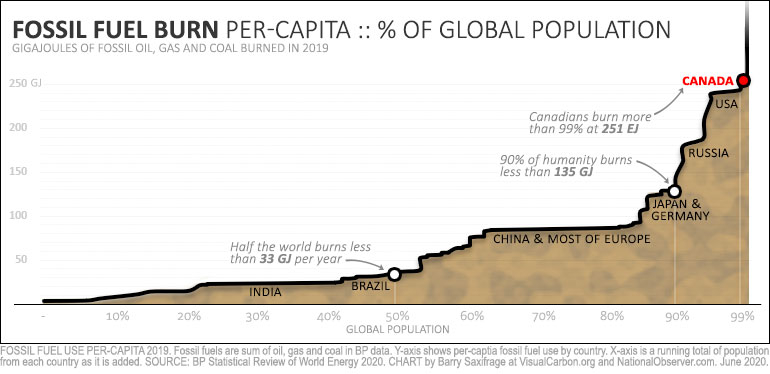
It turns out that we are currently burning more fossil fuels per person than 99 per cent of humanity — nearly five times the global median.
Does this look to you like Canada is doing our fair share in the fight to prevent a full-blown climate crisis?
It sure looks like a top one per cent climate failure to me. Fossil fuels don't burn themselves. We choose to burn them. We could choose to burn less — just like many of our peers have. So far, we've chosen not to. In my opinion, our failure to aggressively turn down our oversized fossil burn is both excessively risky and morally wrong.
If Canadians want to finally get started in the right direction in the climate fight, where could we start? Here are a few options: